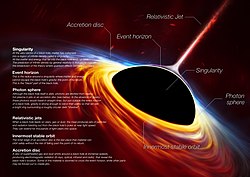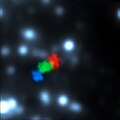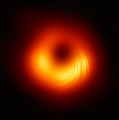Black hole
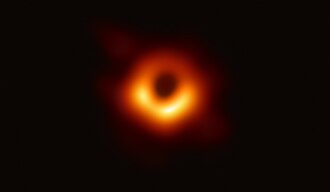
A black hole is a place in space where gravity is so strong that nothing can escape from it, not even light. Black holes are made when a lot of matter is squeezed into a very small space. This idea comes from Albert Einstein's general theory of relativity.[3] The outer edge of a black hole is called the event horizon. When something enters the black hole, it cannot get out. Black holes act like perfect black bodies, which means they do not reflect any light.[4][5] According to quantum mechanics, black holes can slowly release a tiny amount of energy called Hawking radiation. But this radiation is so weak that it cannot be seen with the technology today.
The idea of objects with gravity so strong that light cannot escape was first talked about in the 1700s by John Michell and Pierre-Simon Laplace. In 1916, Karl Schwarzschild found the first solution to Einstein's general relativity equations that was about a black hole. Because of his important work, this solution is called the Schwarzschild metric. In 1958, David Finkelstein was the first to call a black hole a place in space where nothing can escape. For a long time, people thought black holes were just an idea in mathematics. They thought black holes were not real. In 1967, Jocelyn Bell Burnell discovered neutron stars. The first black hole found was Cygnus X-1. It was found by lots of scientists in 1971.[6][7]
Black holes usually form when very large stars die at the end of their life. Black holes can grow by eating gas, dust, stars, or even combining with other black holes. Supermassive black holes are black holes which are millions of times heavier than the Sun. These big black holes might be made by merging with other black holes, eating stars, or from the collapse of huge clouds of gas. Scientists agree that supermassive black holes can be found at the centers of almost every galaxy.
Even though black holes are invisible to us, scientists can still find them. They look at how they affect matter and light near them. When matter falls toward a black hole, it can form a spinning disk called an accretion disk. Friction in the disk heats it up. This makes it glow very brightly. Sometimes, this creates a quasar, one of the brightest things in the universe. This can be found by telescopes on Earth or by telescopes in space such as Chandra or XMM Newton. Sometimes, if a star gets too close to a supermassive black hole, it can be torn apart into a bright stream of gas before being swallowed.[8] Scientists can also find black holes by looking at how stars move. If a star moves around something invisible, scientists can find out the mass and location of the invisible object. This helps them know it is a black hole and not something else like a neutron star. Astronomers have found some black holes. However, "estimates from NASA [... say that maybe there are] as many as 10 million to a billion [black holes or] stellar black holes in the Milky Way", according to media (2025).[9]
One was found at the center of our galaxy. This black hole, called Sagittarius A*, is about 4.3 million times heavier than our Sun.[10]
The black hole closest to Earth, is Gaia BH1. Its distance from Earth is about 1,500 light-years.[11]
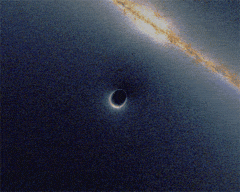
History
In 1783, an English clergyman named John Michell wrote that it might be possible for something to be so heavy you would have to go at the speed of light to get away from its gravity.[12] Gravity gets stronger as something gets more massive. For a small thing, like a rocket, to escape from a larger thing, like Earth, it has to escape the pull of the Earth's gravity or it will fall back. The speed that it must travel to get away is called escape velocity. Bigger planets (like Jupiter) and stars have more mass, and have stronger gravity than Earth. Therefore, the escape velocity would need to be much faster. John Michell thought it was possible for something to be so big that the escape velocity would need to be faster than the speed of light, so even light could not escape.[13] In 1796, Pierre-Simon Laplace wrote about the same idea in the first and second editions of his book Exposition du système du Monde (it was removed from later editions).[14][15]
Some scientists thought Michell might be right, but others thought that light had no mass and would not be pulled by gravity. His theory was forgotten.
In 1916 Albert Einstein wrote an explanation of gravity called general relativity.
- Mass causes space (and spacetime) to bend, or curve. Moving things "fall along" or follow the curves in space. This is what we call gravity.
- Light always travels at the same speed, and is affected by gravity. If it seems to change speed, it is really traveling along a curve in spacetime.
A few months later, while serving in World War I, the German physicist Karl Schwarzschild used Einstein's equations to show that a black hole could exist.[16] The Schwarzschild radius is the size of the event horizon of a non-rotating black hole.[17] This radius was the measurement where the escape velocity was equal to the speed of light. If the radius of a star is smaller, then light is unable to escape, and it would be a dark star, or black hole.
In 1930, Subrahmanyan Chandrasekhar predicted that stars heavier than the sun could collapse when they ran out of hydrogen or other nuclear fuels to burn.[18][19] In 1939, Robert Oppenheimer and H. Snyder calculated that a star would have to be at least three times as massive as the Sun to form a black hole. In 1967, John Wheeler invented the name "black hole" for the first time.[20] Before that, they were called "dark stars".
In 1970, Stephen Hawking and Roger Penrose showed that black holes must exist. Although the black holes are invisible (they cannot be seen), some of the matter that is falling into them is very bright.[21]
As of spring 2019, there was an image of a black hole, or rather, the things orbiting the black hole. The image required many photos from different locations. One of the team members (Katie Bouman) made a compilation of all the images into one singular image.[22]
In 2020, Roger Penrose, Reinhard Genzel and Andrea Ghez were awarded the Nobel Prize in Physics for their work on the theory of black holes.[23]
Formation of black holes
The gravitational collapse of huge (high-mass) stars cause "stellar mass" black holes. This happens when really big stars run out of fuel.
Star formation in the early universe may have created very big stars. These stars were so large that their cores collapsed into black holes. The black hole at the center of these stars slowly consumed the star from within making black holes of up to 103 solar masses. These black holes may be the seeds of the supermassive black holes found in the centers of most galaxies.[24] If these stars really existed, they may even explain where supermassive black holes come from.
Most of the energy released in gravitational collapse is given off very quickly. A distant observer sees the material falling in slowly and then stop just above the event horizon because of gravitational time dilation. The light given off just before the event horizon is delayed an infinite amount of time. So the observer never sees the formation of the event horizon. Instead, the collapsing material seems to become dimmer and increasingly red-shifted, eventually fading away.[25]
Supermassive black holes
Black holes have also been found in the middle of almost every galaxy in the known universe. These are called supermassive black holes (SBH), and are the biggest black holes of all. They formed when the Universe was very young, and also helped to form all the galaxies.
Quasars are believed to be powered by gravity collecting material into supermassive black holes in the centers of distant galaxies. Light cannot escape the SBHs at the center of quasars, so the escaping energy is made outside the event horizon by gravitational stresses and immense friction on the incoming material.[26]
Huge central masses (106 to 109 solar masses) have been measured in quasars. Several dozen nearby large galaxies, with no sign of a quasar nucleus, have a similar central black hole in their nuclei. Therefore, it is thought that all large galaxies have one, but only a small fraction are active (with enough accretion to power radiation) and so are seen as quasars.
Parts of a Black Hole
The Event Horizon
A black hole is separated from the rest of the Universe by its event horizon. Anything which crosses it cannot escape, not even light. Anything that happens inside this boundary can't be seen from the outside.
Near a black hole, time appears to slow down. This is known as gravitational time dilation. This happens because gravity affects time. The stronger the gravity, the slower time passes. Objects seem to turn red and fade away when they reach the event horizon. This is known as gravitational redshift.
The shape of the event horizon for non-rotating black holes is spherical and slightly flattened for spinning ones.
The photon sphere is a spherical boundary of zero thickness in which photons that move on tangents to that sphere would be trapped in a circular orbit about the black hole.
Effect on light

At the middle of a black hole, there is a gravitational center called a singularity. It is impossible to see into it because the gravity prevents any light escaping.
Outside the event horizon, light and matter will still be pulled toward the black hole. If a black hole is surrounded by matter, the matter will form an "accretion disk" around the black hole. An accretion disk looks something like the rings of Saturn. As it gets sucked in, the matter gets very hot and shoots x-ray radiation into space. Think of this as the water spinning around the hole before it falls in.
Most black holes are too far away for us to see the accretion disk and jet. The only way to know a black hole is there is by seeing how stars, gas and light behave around it. With a black hole nearby, even objects as big as a star move in a different way, usually faster than they would if the black hole was not there.
Since we cannot see black holes, they must be detected by other means. When a black hole passes between us and a source of light, the light bends around the black hole creating a mirror image. This effect is called gravitational lensing.[27][28][29]
Hawking radiation
Hawking radiation is black body radiation which is emitted by black holes, due to quantum effects near the event horizon. It is named after the physicist Stephen Hawking, who provided a theoretical argument for its existence in 1974.[30]
Hawking radiation reduces the mass and the energy of the black hole and is therefore also known as black hole evaporation. This happens because of the virtual particle-antiparticle pairs. Due to quantum fluctuations, this is when one of the particles falls in and the other gets away with the energy/mass. Because of this, black holes that lose more mass than they gain through other means are expected to shrink and ultimately vanish. Micro black holes (MBHs) are predicted to be larger net emitters of radiation than larger black holes and should shrink and dissipate faster.
Properties of black holes
The no hair theorem basically says that once a black hole has formed, it only has three physical properties that we can measure: mass, charge, and spin. If this is true, then if two black holes had the same mass, charge and spin then they will look the same. As of 2020, it is unclear if the no hair theorem is true for real black holes.[31]
The properties are special, because all of them can be measured from outside the black hole. For example, a charged black hole repels other like charges just like any other charged object. Similarly, the total mass inside a sphere containing a black hole can be found by using the gravitational analog of Gauss's law, far away from the black hole.[32] The angular momentum or spin can also be measured from far away.[33]
When anything falls into a black hole, any property that is not part of the three properties of a black hole, like shape or charge distribution, gets erased and cannot be seen from outside. This is a very big problem because we lose a lot of information about what went into the black hole, including certain quantum properties and physics tells us that information cannot be destroyed. This puzzle is called the black hole information loss paradox.[34] [35]
Black Hole Media
The first simulated image of a black hole, created by Jean-Pierre Luminet in 1978 and featuring the characteristic shadow, photon sphere, and lensed accretion disk. The disk is brighter on one side due to the Doppler beaming.
Orbits of four photons around a Schwarzschild black hole.
Simulation of two black holes colliding
A view of supermassive black hole M87* in polarised light
Sagittarius A*, the supermassive black hole in the center of the Milky Way
References
- ↑ Overbye, Dennis (2019). "Black hole picture revealed for the first time - Astronomers at last have captured an image of the darkest entities in the cosmos - Comments". The New York Times. http://www.nytimes.com/2019/04/10/science/black-hole-picture.html?comments#permid=31473598. Retrieved 10 April 2019.
- ↑ The Event Horizon Telescope Collaboration (2019). "First M87 Event Horizon Telescope Results. I. The Shadow of the Supermassive Black Hole". The Astrophysical Journal Letters. 87 (1): L1. arXiv:1906.11238. Bibcode:2019ApJ...875L...1E. doi:10.3847/2041-8213/ab0ec7. ISSN 2041-8205. S2CID 145906806.
- ↑ Wald, Robert M. 1984. General Relativity. University of Chicago Press. ISBN 978-0-226-87033-5
- ↑ Schutz, Bernard F. (2003). Gravity from the ground up. Cambridge University Press. p. 110. ISBN 978-0-521-45506-0. Archived from the original on 2 December 2016.
- ↑ Davies, P. C. W. (1978). "Thermodynamics of Black Holes" (PDF). Reports on Progress in Physics. 41 (8): 1313–1355. Bibcode:1978RPPh...41.1313D. doi:10.1088/0034-4885/41/8/004. S2CID 250916407. Archived from the original (PDF) on 10 May 2013.
- ↑ Webster, B. Louise; Murdin, Paul (1972), "Cygnus X-1—a Spectroscopic Binary with a Heavy Companion?", Nature, 235 (5332): 37–38, Bibcode:1972Natur.235...37W, doi:10.1038/235037a0, S2CID 4195462
- ↑ Bolton, C. T. (1972), "Identification of Cygnus X-1 with HDE 226868", Nature, 235 (5336): 271–273, Bibcode:1972Natur.235..271B, doi:10.1038/235271b0, S2CID 4222070
- ↑ Wald, Robert M. 1992. Space, time, and gravity: the theory of the Big Bang and black holes. University of Chicago Press. ISBN 978-0-226-87029-8
- ↑ https://www.space.com/15421-black-holes-facts-formation-discovery-sdcmp.html. Retrieved 2025-05-13
- ↑ "Scientists find proof a black hole is lurking at the centre of our galaxy" (in en-GB). Metro. 2018-10-31. https://metro.co.uk/2018/10/31/scientists-find-proof-a-supermassive-black-hole-is-lurking-at-the-centre-of-the-milky-way-8092994/. Retrieved 2018-10-31.
- ↑ https://science.nasa.gov/universe/black-holes/#:~:text=Essential%20Black%20Hole%20Facts&text=The%20nearest%20known%20black%20hole,about%201%2C500%20light%2Dyears%20away. Retrieved 2025-05-13
- ↑ Wheeler, John Archibald & Ford, Kenneth 1998. Geons, black holes, and quantum foam: a life in physics. New York: W.W. Norton. ISBN 0-393-04642-7
- ↑ Michell J. 1784 (January 1784). "On the means of discovering the distance, magnitude, &c. of the fixed stars, in consequence of the diminution of the velocity of their light, in case such a diminution should be found to take place in any of them, and such other data should be procured from observations, as would be farther necessary for that purpose". Philosophical Transactions of the Royal Society. 74: 35–57. Bibcode:1784RSPT...74...35M. doi:10.1098/rstl.1784.0008. JSTOR 106576.
- ↑ Gillispie C.C. 2000 (27 February 2000). Pierre-Simon Laplace, 1749–1827: a life in exact science. Princeton paperbacks. Princeton University Press. p. 175. ISBN 0-691-05027-9.
- ↑ Israel W. 1989 (30 March 1989). "Dark stars: the evolution of an idea". In Hawking, S. W.; Israel, W. (eds.). 300 years of gravitation. Cambridge University Press. ISBN 978-0-521-37976-2.
- ↑ Schwarzschild, Karl 1916. Über das Gravitationsfeld eines Massenpunktes nach der Einstein’schen Theorie. Reimer, Berlin 1916, S. 189 ff. Sitzungsberichte der Königlich-Preussischen Akademie der Wissenschaften; 1916.
- ↑ Schwarzschild, Karl 1916. Über das Gravitationsfeld einer Kugel aus inkompressibler Flussigkeit nach der Einsteinschen Theorie. Sitzungsberichte der Deutschen Akademie der Wissenschaften zu Berlin, Klasse fur Mathematik, Physik, und Technik (1916) p424.
- ↑ Chandrasekhar S. 1991. Selected Papers, vol 6: The mathematical theory of black holes and of colliding plane waves. Chicago: University of Chicago Press. ISBN 9780226101019
- ↑ Penrose, Roger 1996. Chandrasekhar, black holes and singularities. Journal of Astrophysics and Astronomy. 17 (3–4): 213–231. Bibcode:1996JApA...17..213P. CiteSeerX 10.1.1.496.2529. doi:10.1007/BF02702305. S2CID 119807977. Archived from the original (PDF) on 23 July 2018. Retrieved 4 September 2017.
- ↑ Wheeler, John Archibald 1998. Geons, black holes, and quantum foam: a life in physics. New York: W.W. Norton & Co. ISBN 0-393-04642-7
- ↑ Hawking S.W. & Penrose R (1970). "The singularities of gravitational collapse and cosmology". Proceedings of the Royal Society A. 314 (1519): 529–548. Bibcode:1970RSPSA.314..529H. doi:10.1098/rspa.1970.0021. JSTOR 2416467. S2CID 120208756.
- ↑ "Katie Bouman 'hardly knew what a black hole was'. Her algorithm helped us see one". PBS NewsHour. 2019-04-11. Retrieved 2020-06-10.
- ↑ "The Nobel Prize in Physics 2020". NobelPrize.org. Retrieved 2020-12-08.
- ↑ Rees M.J. & Volonteri M 2007 (2006). Karas, V; Matt, G (eds.). Massive black holes: Formation and evolution. Proceedings of the International Astronomical Union. Vol. 2. Cambridge University Press. pp. 51–58. arXiv:astro-ph/0701512. doi:10.1017/S1743921307004681. ISBN 978-0-521-86347-6. S2CID 14844338.
- ↑ Penrose, Roger 2002 (2002). "Gravitational collapse:the role of general relativity" (PDF). General Relativity and Gravitation. 34 (7): 1141. Bibcode:2002GReGr..34.1141P. doi:10.1023/A:1016578408204. S2CID 117459073. Archived from the original (PDF) on 2013-05-26. Retrieved 2013-01-05.
- ↑ Thomsen D.E. 1987. End of the World: you won't feel a thing. Science News 131 (25): 391.
- ↑ Soldner J.G.V. 1804. On the deflection of a light ray from its rectilinear motion, by the attraction of a celestial body at which it nearly passes by. Berliner Astronomisches Jahrbuch: 161–172.
- ↑ Dyson F.W; Eddington A.S. & Davidson C. 1920. A determination of the deflection of light by the Sun's gravitational field, from observations made at the total eclipse of 29 May 1919. Philosophical Transactions of the Royal Society A: Mathematical, Physical and Engineering Sciences. 220 (571–581): 291–333.
- ↑ A brief history of gravitational lensing — Einstein Online. [1].
- ↑ "Charlie Rose: A conversation with Dr. Stephen Hawking & Lucy Hawking". Archived from the original on 2013-03-29. Retrieved 2012-11-29.
- ↑ Chruściel, Piotr T.; Costa, João Lopes; Heusler, Markus (2012). "Stationary Black Holes: Uniqueness and Beyond". Living Reviews in Relativity. 15 (1): 7. arXiv:1205.6112. Bibcode:2012LRR....15....7C. doi:10.12942/lrr-2012-7. ISSN 1433-8351. PMC 5255892. PMID 28179837.
- ↑ Carroll, Sean M. (2004). Spacetime and Geometry. Addison Wesley. p. 253. ISBN 978-0-8053-8732-2.. The lecture notes on which the book was based are available for free from Sean Carroll's website.
- ↑ Reynolds, Christopher S. (January 2019). "Observing black holes spin". Nature Astronomy. 3 (1): 41–47. arXiv:1903.11704. Bibcode:2019NatAs...3...41R. doi:10.1038/s41550-018-0665-z. ISSN 2397-3366. S2CID 85543351.
- ↑ Anderson, Warren G (1996). "Black Hole Information Loss Problem". Archived from the original on 2009-01-22. Retrieved 2023-09-08.
{{cite web}}: CS1 maint: bot: original URL status unknown (link) - ↑ Preskill, J. (1994). "Black holes and information: A crisis in quantum physics" (PDF). Archived from the original on 2008-05-18. Retrieved 2023-09-08.
{{cite web}}: CS1 maint: bot: original URL status unknown (link)



